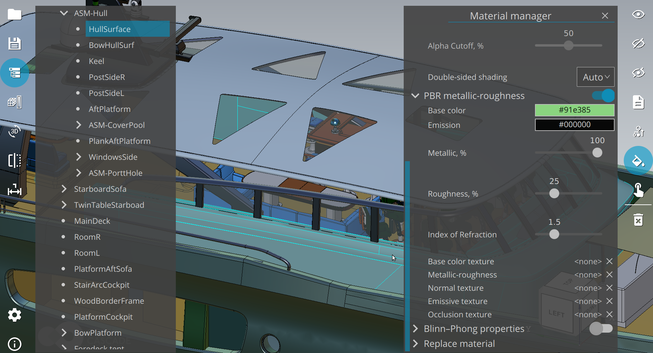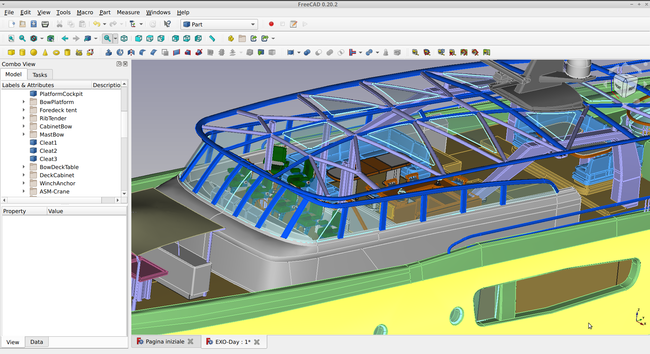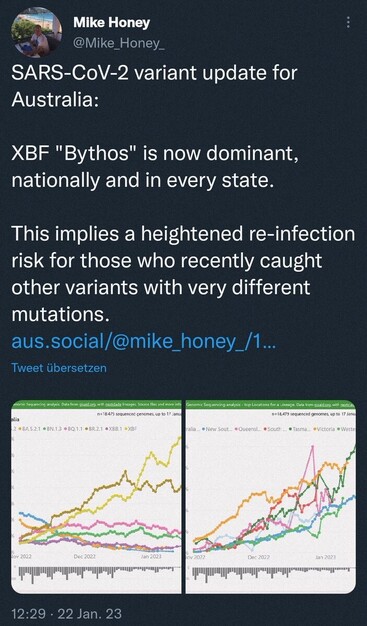Mike Honey · @mike_honey_
2278 followers · 1090 posts · Server aus.socialHere's the latest variant picture for Queensland.
XBB.1.5 "Kraken" (23%) is dominant, but seems to be in decline.
XBF "Bythos" (14%) is hanging on stubbornly.
The sample volumes seem representative up to March 20.
#COVID19 #Australia #QLD #Brisbane #XBB_1_5 #Kraken #XBF #Bythos #FK_1 @auscovid19
🧵
#COVID19 #australia #qld #brisbane #xbb_1_5 #kraken #xbf #bythos #fk_1
pafurijaz · @pafurijaz
104 followers · 441 posts · Server mstdn.socialpafurijaz · @pafurijaz
104 followers · 441 posts · Server mstdn.socialAnd after a while I finally organized the model with colors and groups and subgroups with various assemblies, now saving in #STEP and then creating materials in PBR and saving in #XBF format! #FreeCAD #CAD #opencascade
#opencascade #cad #freecad #xbf #step
Mike Honey · @mike_honey_
2266 followers · 1021 posts · Server aus.socialHere's the latest SARS-CoV-2 variant picture for New Zealand:
XBB.1.5 "Kraken" (36%) became dominant in early March.
It's main rival recently has been the resurgent CH.1.1 "Orthrus" (20%). This variant is hanging on impressively in NZ - in other countries where CH.1.1 was strong, it had faded below 10% by mid-February, as XBB.1.5 took over.
Newcomer XBB.1.9.1 "Hyperion" (7%) has been rising steadily.
XBF "Bythos" has faded below 5%.
Recent sample sizes are very solid and recent, up to March 11 (see grey column chart). However the cadence of updates appears to be roughly monthly, unfortunately.
#COVID19 #NZ #XBB_1_5 #CH_1_1 #Orthrus #Kraken #XBB_1_9_1 #Hyperion #XBF #Bythos
🧵
#COVID19 #nz #xbb_1_5 #ch_1_1 #orthrus #kraken #xbb_1_9_1 #hyperion #xbf #bythos
Mike Honey · @mike_honey_
2246 followers · 913 posts · Server aus.socialLast week a new possible sub-variant of XBF "Bythos" was proposed by Ryan Hisner - characterised by the unusual Spike P621S mutation. The earliest sample reported was from New South Wales, back in October (not shown). Most of the samples globally have been found in South Australia, reporting rapid growth to 12% frequency in mid-February. After very sparse samples elsewhere, the steady growth on consecutive days seems to confirm community spread in South Australia.
I'm searching for those samples here by looking for samples of XBF with the Spike P621S mutation. There are 45 reported globally so far, with a couple in Singapore and 8 in the UK.
#COVID19 #australia #xbf #bythos
Mike Honey · @mike_honey_
2221 followers · 883 posts · Server aus.socialIn recent days a new variant has been proposed - a recombinant of BR.2.1 "Cerastes" and XBF "Bythos". The earliest sample reported so far was from Victoria, in mid-January. All the samples globally have been found in Australia - covering New South Wales, Queensland and South Australia.
Recombinant variants typically arise when an immune-compromised patient is infected with multple variants at once. The more often that happens, and the longer the co-infection, the more chances of recombinant variants being formed and spreading to the broader population.
As recombinant variants have become more common, they are involved in more of these scenarios. This gives the virus a multiplier in it's constant search to find new, more evasive combinations.
I'm searching for those samples here by looking for samples with the Spike F486P and NS8 S82T mutations. There are 10 so far, rising to around 1.5% frequency for Australia. There's now very limited genomic sequencing data shared from other states besides NSW, so this could be going undetected elsewhere.
#COVID19 #Australia #XBF #Bythos #BR_2_1 #Cerastes @auscovid19
🧵
#COVID19 #australia #xbf #bythos #br_2_1 #cerastes
Mike Honey · @mike_honey_
2220 followers · 878 posts · Server aus.socialHere's the latest SARS-CoV-2 variant picture for New Zealand:
The XBF "Bythos" variant has grown steadily to 21%, and is now the dominant individual variant. XBB.1.5 "Kraken" has grown to 10%.
The BA.2.75.* clan variants are led by CH.1.1 "Orthrus" at 16%, followed by child CH.1.1.7 at 14%. BR.2.1 "Cerastes" is at 10%.
The BQ.* and BA.5.* variants continue to fade, down to 5% or less.
Definitely a swarm of variants about, but the trend is towards the recombinant variants with the Spike F486P mutation: XBF and XBB.1.5,
Recent sample sizes are very solid and recent, up to February 6 (see grey column chart).
#COVID19 #NZ #XBF #Bythos #XBB_1_5 #Kraken #XBB_1_9_1 #Hyperion
🧵
#COVID19 #nz #xbf #bythos #xbb_1_5 #kraken #xbb_1_9_1 #hyperion
Mike Honey · @mike_honey_
2199 followers · 812 posts · Server aus.socialHere's the latest variant picture for Singapore:
After a long lull under the XBB.1 "Hippogryph" variant, new variants are vying for dominance in Singapore, launching a new wave.
The leading candidates so far are CH.1.1.1, a child of "Orthrus" (12%), XBB.1.5 "Kraken" (11%) and XBF "Bythos" (reached 10%, possibly fading).
The fairly strong showing by XBF might help explain why XBB.1.5 has been so slow to take off in Australia, where XBF is dominant.
Recent samples look representative, up to 29 January.
#COVID19 #Singapore #CH_1_1_1 #Orthrus #XBB_1_5 #Kraken #XBF #Bythos
🧵
#COVID19 #singapore #ch_1_1_1 #orthrus #xbb_1_5 #kraken #xbf #bythos
wohllust · @franklutze
0 followers · 744 posts · Server social.anoxinon.deRT @moogoonoog
Was momentan in Australien passiert, klingt sehr beunruhigend.
Mike Honey · @mike_honey_
2143 followers · 764 posts · Server aus.socialHere's the latest variant picture for Australia - the chaotic swarm appears to be resolving with XBF "Bythos" now clearly dominant at 35%, nationally and now in every state. This rapid takeover after the November-December wave implies a hightened re-infection risk for those who caught other variants with very different mutations.
The rest of the swarm is fading slowly but there is still great diversity.
Recent sample sizes are smaller, but the daily sizes look representative up to 11 January (see grey column chart). Representative recent samples have been shared from most states, although samples from other jurisdictions lag NSW and Tasmania by 1-3 weeks, with SA and ACT lagging the most. There's a large gap in the samples from QLD in late-December. Samples have not been shared from the NT for almost a year.
Mike Honey · @mike_honey_
2145 followers · 756 posts · Server aus.socialHere's the latest variant picture for Sweden:
The clan of BQ.* lineages (50%) - led by the BQ.1.1 "Cerberus" lineage (17%) - rose to dominance during November, starting a wave of cases and deaths.
XBF "Bythos" (10%) rose sharply during early January.
XBB.1.5 "Kraken" is present (2%), but is not growing as fast as XBF. XBF is rated just below XBB.1.5 for immune escape, and slightly higher for ACE2 binding (see below), so it will be interesting to see how that plays out.
Recent sample sizes are smaller.
#COVID19 #Sweden #BQ #Cerberus #XBF #Bythos #XBB_1_5 #Kraken
🧵
#COVID19 #sweden #bq #cerberus #xbf #bythos #xbb_1_5 #kraken
Mike Honey · @mike_honey_
2145 followers · 750 posts · Server aus.socialHere's the latest variant picture for Western Australia:
The XBF "Bythos" recombinant lineage has surged to dominate the intensely chaotic swarm (26%). XBF has been dominant in Victoria throughout the current wave and is now growing in other states, also in New Zealand, Sweden and others. XBF "Bythos" is rated just below XBB.1.5 "Kraken" for immune escape, and slightly higher for ACE2 binding, so it's success should not be a surprise.
The new XBC.1.1 recombinant "Deltacron" lineage is also showing strong growth (16%). It's grand-parent XBC was a combination of BA.2 and B.1.617.2* (Delta), presumed to originate in the Philippines. XBC.1.1 has evolved through a couple of generations with extra mutations, which appear advantageous.
XBC.1.1 is quite rare outside Australia, and is at low frequencies (1-2%) in other states. So WA will be keenly watched, as the launchpad of what I beleive is already the most succesful "Deltacron" lineage anywhere, ever.
The earliest sample reported of XBC.1.1 was from Queensland in October, so it looks like another successful Australian contribution to the global diversity of SARS-CoV-2.
The CH.1.1 "Orthrus" lineage has faded recently against intense competition, not making the top 7.
Recent sample sizes are smaller.
#COVID19 #australia #wa #xbf #xbc_1_1
Mike Honey · @mike_honey_
2132 followers · 719 posts · Server aus.socialHere's the latest SARS-CoV-2 variant picture for Australia:
The steady growth of the XBF recombinant lineage appears to have accelerated recently, now dominant at 37%. It has displaced the BR.2.1 lineage, now around 20%.
There are other significant contributors e.g. BQ.1.1 "Cerberus" and BN.1.3 (a child of BN.1 "Hydra") forming the unique swarm of lineages and recent infections in Australia. It's hard to predict how this unprecendented scenario will play out.
Recent sample sizes are smaller.
#COVID19 #australia #xbf #xbb_1_5 #kraken
Mike Honey · @mike_honey_
2132 followers · 724 posts · Server aus.socialHere's the latest SARS-CoV-2 variant picture for New Zealand:
The BA.2.75.* clan lineages are now dominant at 52%. CH.1.1 "Orthrus" is the leading lineage in this clan at 32%. BR.2.1 (dominant in New South Wales) has slowly grown to 10%.
The X* recombinant lineages have been growing slowly. This includes the XBF "Bythos" lineage at 8%, which has showed strong growth in Victoria, Australia. There were only 2 samples reported for XBB.1.5 "Kraken" so far.
The BQ.* lineages (led by BQ.1.1 "Cerberus") are flat at around 22%.
The BA.5.* lineages continue to fade, down to 17% of recent samples. Recently infected Kiwis are 5:1 more likely to have caught one of the many new lineages.
It's hard to predict how this unprecendented scenario will play out. This particular combination seems unique to NZ.
Recent sample sizes are very solid and recent, up to Dec 19 (see grey column chart).
Mike Honey · @mike_honey_
1996 followers · 646 posts · Server aus.socialHere's the latest variant picture for Australia - the chaotic swarm of new lineages continue vying for dominance in each state:
There's continued recent growth from the BA.2.75.* lineages (41%). The BA.2.75.* clan includes the BR.2.1 (18%) and CH.1.1 "Orthrus" (4%) lineages, and many more. These are more prevalent in New South Wales and Tasmania (details below).
The X* clan of recombinant lineages includes the new XBF "Bythos" lineage, which is showing steady growth (22%) - mostly in Victoria (details below), but rising rapidly in most other states now.
Growth of the BQ.* lineages appears to have plateaued (21%). These seem far more prevalent in South Australia (details below), and are led by the BQ.1.1 "Cerberus" lineage (9%).
The BA.5.* lineages continue to fade, down to 12% of recent samples.
Recent sample sizes are smaller, but the daily sizes look representative up to 15 December (see grey column chart). Representative recent samples have been shared from most states, although WA and SA lag the others by about a week. Samples shared from the ACT stalled in November. Samples have not been shared from the NT for many months.
#COVID19 #australia #br_2_1 #ch_1_1 #bq #xbf
Mike Honey · @mike_honey_
1751 followers · 565 posts · Server aus.socialHere's the latest variant picture for Australia - an unprecedented chaotic swarm of new lineages are vying for dominance in each state:
There's continued recent growth from the BA.2.75.* lineages (40%). The BA.2.75.* clan includes the BR.2.1 (19%) and CH.1.1 "Orthrus" (5%) lineages, and many more. These are more prevalent in New South Wales and Tasmania (details below).
Growth of the BQ.* lineages appears to have plateaued (18%). These seem far more prevalent in South Australia (details below), and are led by the BQ.1.1 "Cerberus" lineage (4%).
The X* clan of recombinant lineages includes the new XBF "Bythos" lineage, which is showing steady growth (12%) - mostly in Victoria (details below), but rising rapidly in most other states now.
The BA.5.* lineages continue to fade, down to 18% of recent samples.
Recent sample sizes are smaller, but the daily sizes look representative up to 30 November (see grey column chart). Representative recent samples have been shared from most states - VIC lags about a week. Samples shared from the ACT resumed recently, but is now lagging by several weeks. Samples have not been shared from the NT for many months.
#COVID19 #australia #br_2_1 #ch_1_1 #bq #xbf
Mike Honey · @mike_honey_
1745 followers · 560 posts · Server aus.socialHere's the latest SARS-CoV-2 variant picture for New Zealand:
The BA.5.* lineages continue to fade, down to 37% of recent samples. Recently infected Kiwis are 2:1 more likely to have caught one of the many new lineages.
There's continued recent growth from the BA.2.75.* lineages (33%) - the leading challenger. The BA.2.75.* clan includes the CH.1.1 "Orthrus" lineage, and more (details below).
BQ.* lineages also grew steadily, but growth appears to have slowed recently (21%).
The X* lineages have been growing more slowly, and also seem flat recently (8%). The X* clan of recombinant lineages includes the new XBF "Bythos" lineage, which has showed strong growth in Victoria, Australia. XBB.1 "Gryphon" was dominant in Singapore, but has peaked in NZ at 3% so is not a significant factor.
It's hard to predict how this unprecendented scenario will play out. Perhaps natural immunity from CH.1.1 infections will suppress the rise of the other new lineages, or not. This particular combination seems unique to NZ.
Recent sample sizes are very solid and recent, up to Nov 28 (see grey column chart).
daryl · @darylgibson
55 followers · 10 posts · Server mastodon.socialSARS-CoV-2 XBF lineage in Australia and New Zealand
The new XBF recombinant lineage is showing very strong growth - mostly in Australia and New Zealand.
Due to data integration constraints, I don't have coverage of XBF in Europe (besides Denmark) and North America (besides Canada).
#COVID19 #XBF #Australia #NZ @auscovid19
🧵
Mike Honey · @mike_honey_
1699 followers · 530 posts · Server aus.socialThe new XBF recombinant lineage is showing very strong growth - mostly in Australia and New Zealand.
Due to data integration constraints, I don't have coverage of XBF in Europe (besides Denmark) and North America (besides Canada).
Joanna Masel · @JoannaMasel
895 followers · 205 posts · Server ecoevo.social@stellar_simon @mike_honey_ Now that is definitely the perfect name! We should start calling #XBF Victoria Bitter (VB).

















